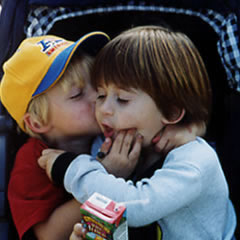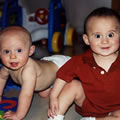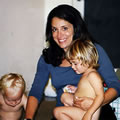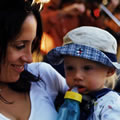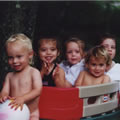
AN OPPORTUNITY TO TEACH CONFLICT RESOLUTION Dr. Pamela Varady Apart from not having
as many arms as an octopus, one of the most challenging aspects
of parenting, is helping our children manage their seemingly never
ending conflicts. “He spilled my juice”, “That’s
my truck”, “He said a bad word to me”, “
That was my cookie”, “ No my cookie”. And on and
on it goes. Although this can be wildly draining, if not maddening,
these sibling conflicts offer us an opportunity as parents (actually
countless opportunities) to teach a most important life skill. A
skill that makes or breaks every adult relationship we have- work,
familial, and intimate relations alike. The skill is conflict resolution
and it shapes how well we negotiate in relationships when our needs
are not being met. Emotional Intelligence is inextricable from high
self- esteem and good character. It
I like to think of discipline as an opportunity to teach my children these coping skills so they can become confident, emotionally intelligent people, and in doing so, my role as disciplinarian is reframed to that of my children’s emotional coach. One reward for taking on the job of emotional coach is that you get to say adios to the less appealing jobs parents often unwittingly assume- cop, judge, and jury. As emotional coach you wouldn’t be concerned with who started it? Our whose cookie is whose? Was it an accident or on purpose? You would not run out and buy two of the same exact toys to avoid conflict. Nor would you give a time-out for every angry outburst. So what would you be doing instead when your kids misbehave? You would be thinking about your purpose as a parent: to help your kids feel good about themselves and do well in relationships. You would be appreciating your unique opportunity to shape your children’s emotional life through teaching coping skills. Conflict resolution is one coping skill and it includes many elements: negotiation, empathy, communication skills and creative thinking. Here are some of the steps you can use to teach
conflict resolution with your twins: Just this morning, I had a “teaching opportunity” with my four year olds, Max and Dylan. While in the kitchen fixing my 10,684th peanut butter and jelly sandwich, I heard bloodcurdling screams coming from my kids’ room. After sneaking in one bite of their sandwich, I flew into their room and found two enraged animals—I mean little boys, in the heat of things. After ascertaining that no one was physically hurt, I stepped into the role of emotional coach. First, I encouraged Max to notice how “ he is really burning inside”, and then, say he is very angry and didn’t like that his brother took his only baseball card. (show better ways to express anger.) Now, telling him to say he is angry might seem too obvious a statement, but when a child is able to name something, especially his own difficult feelings, it gives him a sense of control over himself and his world. (Anyway, this is a most welcomed change from hitting his brother in the head with a bat!)
All the while, I have them facing each other. This way they are more likely to read each other correctly and feel understood. (One of the problems with bullies at school is they misread the facial expressions and intentions of others.) I said to Dylan, “ Look at his face… How do you think he feels?… What can you do or say when you want the card?” (show better ways to express himself when his needs aren’t being met.) Now, Dylan’s facial expressions are saying something quite different in reaction to Max’s appropriate verbal expression of anger. And, with a little coaching Dylan replied, “ I’m sorry I took it, but I really, really, really, want it too!” Then I said, “Hum, we have two boys and only one baseball card (state the conflict), what can you do (invite a resolution)?” “This is a hard one, but mommy knows you two are smart enough to figure it out (show confidence in their ability to figure it out)”. I had to stay with them initially and encourage them to take turns with creative solutions to their dilemma until at last they agreed on a solution. Some children enjoy this creative challenge as much as the original activity! My kids decided to play toy store. Max transformed into store- owner and Dylan, customer, and the baseball card was one of many items they both had the chance to handle. (In minutes, I returned to the kitchen with my loyal snack. Yeah, for mommy!) It’s not always easy, but by following these steps you can help your children weather their emotional storms. Resolving conflicts in this way helps increase their emotional intelligence, and allows you an occasional glimpse of peace and quiet . |
